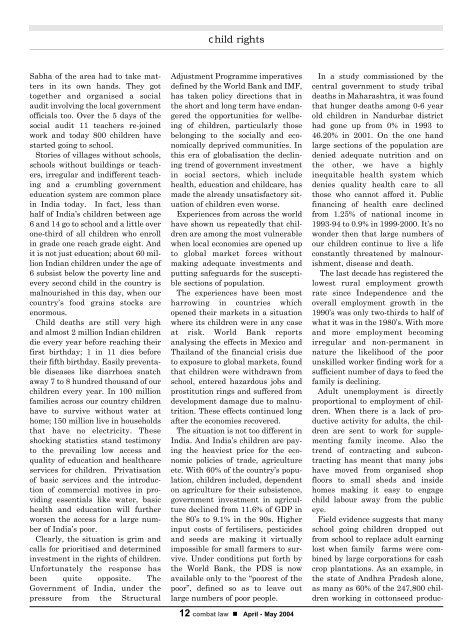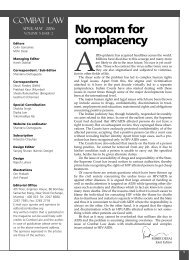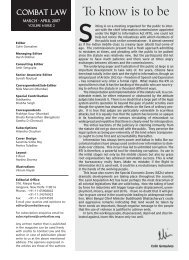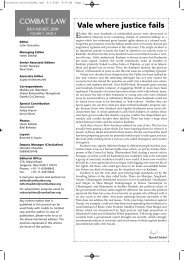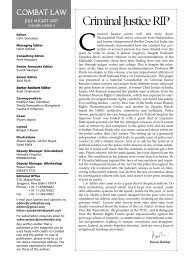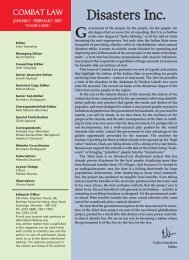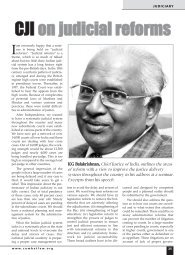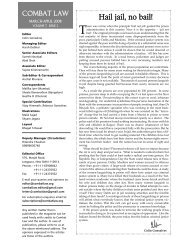PDF, 1.1MB - Combat Law
PDF, 1.1MB - Combat Law
PDF, 1.1MB - Combat Law
Create successful ePaper yourself
Turn your PDF publications into a flip-book with our unique Google optimized e-Paper software.
child rightsSabha of the area had to take mattersin its own hands. They gottogether and organised a socialaudit involving the local governmentofficials too. Over the 5 days of thesocial audit 11 teachers re-joinedwork and today 800 children havestarted going to school.Stories of villages without schools,schools without buildings or teachers,irregular and indifferent teachingand a crumbling governmenteducation system are common placein India today. In fact, less thanhalf of India’s children between age6 and 14 go to school and a little overone-third of all children who enrollin grade one reach grade eight. Andit is not just education; about 60 millionIndian children under the age of6 subsist below the poverty line andevery second child in the country ismalnourished in this day, when ourcountry’s food grains stocks areenormous.Child deaths are still very highand almost 2 million Indian childrendie every year before reaching theirfirst birthday; 1 in 11 dies beforetheir fifth birthday. Easily preventablediseases like diarrhoea snatchaway 7 to 8 hundred thousand of ourchildren every year. In 100 millionfamilies across our country childrenhave to survive without water athome; 150 million live in householdsthat have no electricity. Theseshocking statistics stand testimonyto the prevailing low access andquality of education and healthcareservices for children. Privatisationof basic services and the introductionof commercial motives in providingessentials like water, basichealth and education will furtherworsen the access for a large numberof India’s poor.Clearly, the situation is grim andcalls for prioritised and determinedinvestment in the rights of children.Unfortunately the response hasbeen quite opposite. TheGovernment of India, under thepressure from the StructuralAdjustment Programme imperativesdefined by the World Bank and IMF,has taken policy directions that inthe short and long term have endangeredthe opportunities for wellbeingof children, particularly thosebelonging to the socially and economicallydeprived communities. Inthis era of globalisation the decliningtrend of government investmentin social sectors, which includehealth, education and childcare, hasmade the already unsatisfactory situationof children even worse.Experiences from across the worldhave shown us repeatedly that childrenare among the most vulnerablewhen local economies are opened upto global market forces withoutmaking adequate investments andputting safeguards for the susceptiblesections of population.The experiences have been mostharrowing in countries whichopened their markets in a situationwhere its children were in any caseat risk. World Bank reportsanalysing the effects in Mexico andThailand of the financial crisis dueto exposure to global markets, foundthat children were withdrawn fromschool, entered hazardous jobs andprostitution rings and suffered fromdevelopment damage due to malnutrition.These effects continued longafter the economies recovered.The situation is not too different inIndia. And India’s children are payingthe heaviest price for the economicpolicies of trade, agricultureetc. With 60% of the country’s population,children included, dependenton agriculture for their subsistence,government investment in agriculturedeclined from 11.6% of GDP inthe 80’s to 9.1% in the 90s. Higherinput costs of fertilisers, pesticidesand seeds are making it virtuallyimpossible for small farmers to survive.Under conditions put forth bythe World Bank, the PDS is nowavailable only to the “poorest of thepoor”, defined so as to leave outlarge numbers of poor people.12 combat law • April - May 2004In a study commissioned by thecentral government to study tribaldeaths in Maharashtra, it was foundthat hunger deaths among 0-6 yearold children in Nandurbar districthad gone up from 0% in 1993 to46.20% in 2001. On the one handlarge sections of the population aredenied adequate nutrition and onthe other, we have a highlyinequitable health system whichdenies quality health care to allthose who cannot afford it. Publicfinancing of health care declinedfrom 1.25% of national income in1993-94 to 0.9% in 1999-2000. It’s nowonder then that large numbers ofour children continue to live a lifeconstantly threatened by malnourishment,disease and death.The last decade has registered thelowest rural employment growthrate since Independence and theoverall employment growth in the1990’s was only two-thirds to half ofwhat it was in the 1980’s. With moreand more employment becomingirregular and non-permanent innature the likelihood of the poorunskilled worker finding work for asufficient number of days to feed thefamily is declining.Adult unemployment is directlyproportional to employment of children.When there is a lack of productiveactivity for adults, the childrenare sent to work for supplementingfamily income. Also thetrend of contracting and subcontractinghas meant that many jobshave moved from organised shopfloors to small sheds and insidehomes making it easy to engagechild labour away from the publiceye.Field evidence suggests that manyschool going children dropped outfrom school to replace adult earninglost when family farms were combinedby large corporations for cashcrop plantations. As an example, inthe state of Andhra Pradesh alone,as many as 60% of the 247,800 childrenworking in cottonseed produc-


